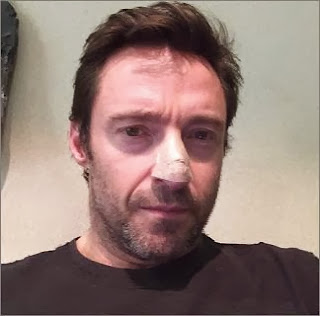By now, you’ve most likely seen this photo of Hugh Jackman.
The Wolverine himself announced to the world that he had skin cancer,
basal cell carcinoma, removed from his nose.
The bandage wasn't because he had plastic surgery or was in a fight. He had skin
cancer. This photo made it to all the
entertainment news shows while the phrase “skin cancer” was simultaneously
spoken. That’s a good step to increasing
awareness. But what exactly is basal
cell carcinoma and how serious is it?
Basal Cell Carcinoma (BCC) are abnormal growths from the basal cells of
the skin, which are located in the deepest layer of the outer skin. The
very rarely spread to other areas of the body, but they can grow in size and
become disfiguring if not addressed.
BCC usually occurs on skin that is exposed to the sun the most, such as
on the nose, ears, face, scalp, neck, shoulders or back. It can develop by other means (radiation
exposure, contact with arsenic, tattooing, complications from burns, etc.) but
UV radiation is the primary cause.
While anyone can get it, those with fair skin, red or blonde hair, and
blue or green eyes are more likely to be diagnosed with BCC. Treatments can range from topical
medications, cryosurgery (“freezing it off”), radiation, or Mohs surgery. Basal Cell Carcinoma is rarely fatal, but
again, can become rather disfiguring and scarring, particularly if left
untreated.
Skin cancer in general is diagnosed annually more than cancers of the
breast, colon, lung and prostate combined!
BCC is the most common form of skin cancer with about 2.8 million occurrences
diagnosed every year.
Basal Cell Carcinoma is very treatable and, unfortunately has led to
the “simply cut out skin cancer” mentality.
But even if the treatment is that simple, multiple scars and potentially
disfiguring surgery is never a preferred choice for anyone, particularly A-list
Hollywood stars. BCC can be quite
serious, even if it is “just skin cancer.”
I invite you to visit the Skin Cancer Foundations website at www.skincancer.org for more information.





